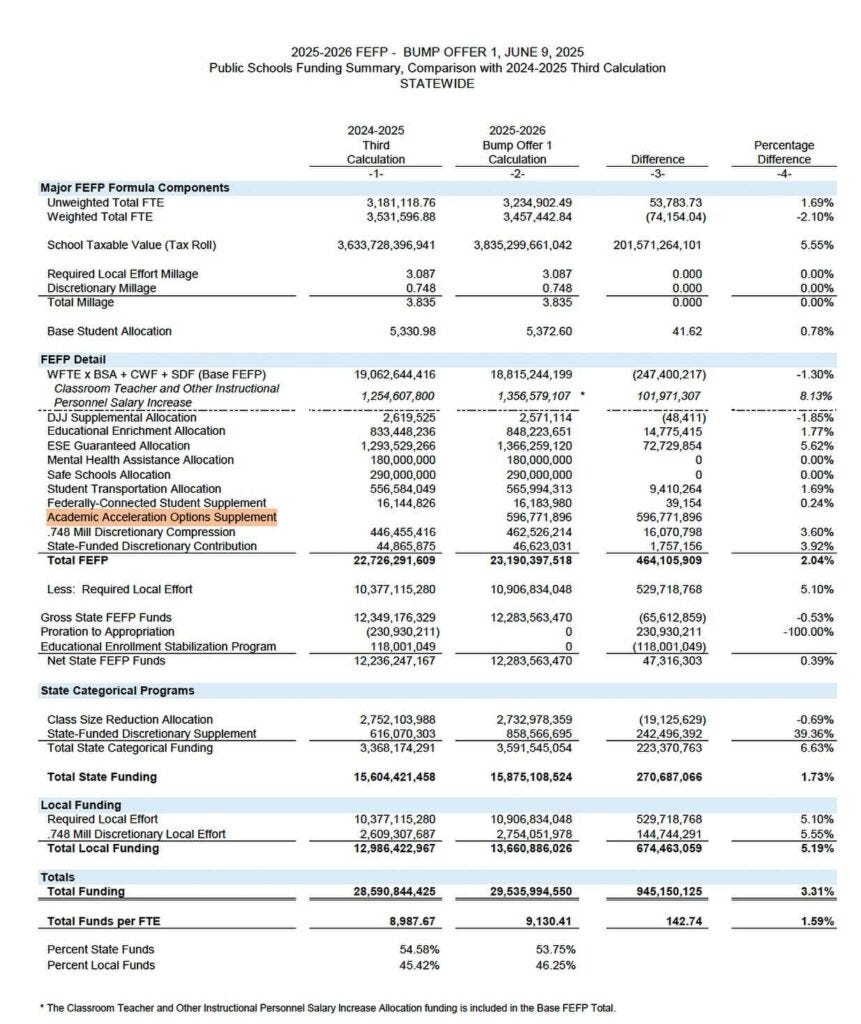Monday, June 30th marked the final day of the 2024-25 Fiscal Year for Florida’s school districts—and it was chaotic to the bitter end.
Governor Ron DeSantis signed the FY 2024-25 budget just hours before it was set to take effect. As has become routine, the per-pupil funding failed to keep pace with inflation. And when combined with increased Florida Retirement System (FRS) contribution requirements and the ongoing mandate for minimum teacher salaries, school districts are left trying to make the numbers work while treading water—or worse.
Also on Monday, just before 5pm, DeSantis released his annual veto list, cutting $567 million from the state budget, further straining some districts’ already-tight finances.
And, as if that wasn't enough... At 2 p.m., state officials received an unsigned email U.S. Department of Education announcing that the Trump Administration would be holding back nearly $6.8 billion in federal K-12 education funding, including $398 million meant for Florida schools. These funds—earmarked for the country’s most vulnerable students—had already been approved by Congress and signed into law in March, with a scheduled release of July 1. According to the message, the holdback was to ensure districts comply with the administration’s current “positions, policies, and best practices.”
Districts across Florida are now scrambling to determine how this unprecedented move will impact their 2025-26 budgets, which took effect the very next day.
As a public education advocate and long-time observer of Florida’s policy choices and privatization schemes, I should be used to this. Chaos and disruption have become the status quo when it comes to undermining public education.
But this week has felt "extra."
About That Budget...
DeSantis celebrated the K-12 budget with a press release titled “EDUCATING FLORIDA’S STUDENTS,” packed with the usual hyperbole and what appeared to be several typos.
The press release claimed:
“Whether a focus on workforce education, teacher quality, school safety, or academic progress, Florida remains steadfast in delivering a world-class education system.”
But, does this seem like "a world-class education system?:
Florida middle school reading and math scores have been in decline since before the pandemic.
SAT and ACT scores are dropping, with Florida now ranking near the bottom among states.
Florida ranks 50th in average teacher pay—for the second year in a row.
Florida leads the nation in book bans.
If this is “world-class,” perhaps the Governor is using a different dictionary...
The spin continued:
“Over the past few years, sweeping education reform has led to Florida being a national leader in education… #1 in education freedom… #1 in higher education…”
But here’s what he left out: While Florida’s higher education ranking remains #1 per U.S. News & World Report, Florida’s overall education ranking has dropped—primarily due to its PreK-12 ranking plummeting from #10 in 2024 to number #22 in 2025.
Reality Check on Funding
The press release touts a “historic” $15.9 billion for the K-12 public school system, including “the highest per-student investment ever” at $9,130, up $143 from last year. But this is misleading.
The actual total FEFP (Florida Education Finance Program) is $29.54 billion. The $15.9 billion is the state’s contribution, which, this year, is a decreased proportion of the total. Local property taxpayers are picking up more of the tab.
And no, this is not the highest per-student funding on record. The real high-water mark was 2007-08, when per-pupil funding was $7,305.79. Adjusted for inflation, that’s $11,326.97 in today’s dollars—more than $2,000 above this year’s so-called record.
And About Those Vouchers...
The 2025-25 FEFP budget funds a projected 429,000 students using Florida’s school choice vouchers through the Family Empowerment Scholarship at a cost of nearly $4 billion dollars. The cost includes funding for nearly 60,000 new voucher students who never attended Florida public school - at a cost of over $545 million, which is almost 60% of the total increased funding in the FEFP... In other words, the 60,000 new voucher students, representing fewer than 2% of the overall publicly funded student population are sucking up the majority of the new FEFP funding.
Let’s Look at the Rest of The “Highlights” (and Reality Checks):
$1.36 billion for teacher and instructional staff salary increases
(An increase of $101.6 million = roughly $20 more per paycheck per teacher.)$1.6 billion for early childhood education, including $434.2 million for VPK
(No increase in the base funding for VPK.))$290 million for Safe Schools Allocation
(Exactly the same as last year.)$2.8 million for the Summer Bridge Program for VPK students with low test scores
(Yes, they are making "low performing" preschoolers take summer school. Last year’s funding was $4.3 million—another cut.)
Conclusion: Same Playbook, Higher Stakes
In the final hours of the fiscal year, Florida’s education system took hit after hit—from insufficient state support, to opaque voucher spending, to a sudden and politically charged federal funding freeze.
It’s not just underfunding—it’s strategic instability. And while the Governor celebrates “record” investments and “education freedom,” school districts are left holding the bag, juggling rising costs and dwindling resources.
The timing, the spin, the chaos—it’s all part of the same playbook. But with $398 million in federal funds suddenly on ice and district budgets already strained, the stakes for Florida’s public schools—and the students they serve—just got a lot higher.




Wow - none of this should surprise me ! Thank you for making it crystal clear Sue!